H
O M E • V
O R T E X 1 • V
O R T E X 2 • V
O R T E X 3 • V
O R T E X 4 • V
O R T E X 5 •
P E R S O N A
L B L O G

 |
| War
Art and Artists : Theatres of War |
||
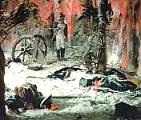 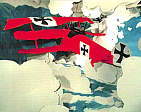
|
Scott Barden: Napoleana
- from Costume, backdrop to prop Scott Barden's work deals with the Napoleonic War, American Civil War and the First World War. One of his aims is to highlight the speciousness of flamboyant uniforms, clothes more suited for a dinner banquet than the realities of the mud and gore of battle, an ironic juxtoposition exaggerated still further by a choice of materials such as papier-mache.Barden himself makes every compositional element - from costume, backdrop, to prop. Finally, people (including Scott) appear in the scenarios to be photographed. The photographs (some epic in scale) then become the final work of art. Images : "Infanterie Avant "Photography and multimedia 92 cms x 153 cms Image no. 2 taken from fotogallery exhibition, Cardiff, Wales, 1997 'A collaboration between Scott Barden and Dave Daggers (photographer and body painter, film maker). |
|
| War
Art and Artists : Theatres of War |
||
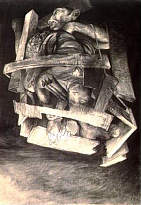 |
Gerald Davies: Images
Compacted with Personal Fear and Vision (when Artist in Residence at Durham Cathedral) "Eighteen months ago my initial project was to be a caustic anti-war statement on a heroic scale. I saw wall-sized cinematic works, treatments of allegories of national honour, individual heroism and collective sacrifice, ironically overwritten with images of confusion, cruelty and waste. Yet again I found my drawings side-stepping this exalted aim. I drew not from a position of 'informed social critic' but as an anxious son and fearful father. the big historical picture became compacted with a personal fear or vision. As time and each new international catastrophe sped by, my visual language became less controlled, at times hallucinatory and fragmented, the content more poetic, personal and particular. The subject of National Rights and Civic Responsibility never appeared but a drawing called 'Rain' emerged. it bought together thoughts of 'document cleansing' in Kosova with my growing awareness of being a Welsh man living in England - when would my name, birth certificate and allegiances become 'nationalist' issues." Gerald Davies graduated from the Royal College of Art in 1984 having won prizes for both figurative art and drawing. Since then he has gone on to receive many awards, becoming artists in residence at Durham cathedral. He is currently a senior lecturer at Lancaster University. top |
|
| War Art and Artists : Theatres of War | ||
| Anna Farthing: A
Submarine Rescue in Cardigan Bay '‘Spinning dits’ is naval slang for telling stories. The following quotation confirms the value that is placed upon maintaining ‘dit’ culture among, in this case, The Royal Marines. Telling stories or ‘spinning dits’, so fundamental to life in the Corps, has become an important way of sustaining our ethos. The Royal Marines have a dit for every occasion and a good dit is precisely the one, which correctly reflects ‘Royal’s’ understanding of himself….Dits are a crucial means by which members of The Royal Marines maintain their history, communicate to each other knowledge and skills, but most importantly the attitudes so necessary to the performance of our role.' www.royalnavy.mod.uk/royalmarines/history-and-ethos/ethos-beliefs/ The events that took place in Cardigan Bay in February 1946 are documented in the records of The Royal Navy, the Royal National Lifeboat Institution and Hansard. But these official accounts are impersonal, they do not communicate knowledge, skills or attitudes, and therefore cannot function as ‘dits’. The story first came to my notice through the first hand account of Des Davies, the last surviving member of the Aberystwyth Lifeboat, Frederick Angus. He spins a great ‘dit’ and his dramatic personal recollections can be found online at : www.bbc.co.uk/wales/mid/sites/aberystwyth/pages/des_davies.shtml Some of the smaller details of Des Davies’ account, and the comments that followed from online contributors (quoted below) inspired me to imagine what the ‘dits’ of those on the margins of this event might be. I have therefore attempted to fictionalize a voiced text and dramatise the sub-text. My creative responses take the form of the following digital audio stories. They are constructed from voice performance and selected sound effects. They are available both here and/or as downloads so that they can be listened to near Cardigan Bay if desired. Washing the White Wooly Pully Written by Anna Farthing, performed by Saskia Portway 'The survivors were taken to a hotel and provided for by the ship wrecked mariners society, their clothes dried by the Aberystwyth steam laundry.' Watching and Waiting Written by Anna Farthing, performed by Anthony Moll 'Some public spirited individual brought a huge telescope on its stand and positioned it outside the public shelter opening on to the prom between the band stand and the Marine Hotel. He allowed us all to look at the submarine (I was 13 years old at the time)' William Cantrell Ashley Written and performed by Anna Farthing (It is interesting to note here that this lifeboat was of the old pulling and sailing type and that this was probably the last service launch of a sailing lifeboat around the UK coast.) Acknowledgements I am grateful to the RNLI archives in Poole, The Lifeboat Museum in Chatham, The Submarine Museum in Gosport, The Royal Naval Museum in Portsmouth, The National Waterfront Museum in Swansea and especially to my yachtsman father, Tony Farthing, who has shared my enthusiasm for this research. Thanks to the RNLI, an entirely voluntary service, he survived his youth and I exist. www.rnli.org.uk top |
||
| War
Art and Artists : Theatres of War |
||
 
|
Lesley Giles: Residues
of War in eastern Europe, TheHortobagy 'I visited Eastern Europe as a landscape artist following the collapse of the Berlin Wall. I was particularly struck by the contrast between undeveloped, isolated, farming communities and the aggressive, strident, Soviet Socialist sculptures dominating even the smallest village centre. Dotted around the countryside were de-commissioned Russian tanks pointing west, remnants of the Cold War. This painting juxtaposes a modern, mechanical weapon against one of the few surviving shaduk-type wells remaining in Europe. The Hortobagy, a National Park, preserves the most westerly area of Asian Steppe still in existence.' Lesley Giles studied at Goldsmiths College and the Royal College of Art, London. She was awarded 2nd prize in the Spirit of London show in 1980, and the New Contemporaries Windsor and Newton Painting Prize in 1976. She has shown in the UK and abroad, notably in China with 'The Light of Xinjiang' at Urumqi. Her work is reproduced in The Challenge of Landscape by Ian Simpson (1991), and Watercolour Masterclass by Laurence Wood (1993). top |
|
| War
Art and Artists : Theatres of War |
||
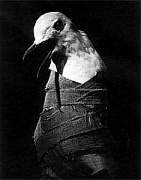 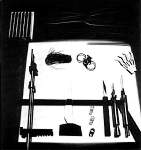
|
Denis Masi: Identifying
the Barrier - Pushing Through 'Barrier' confronts us with a strange and disturbing spectacle. On a black cloth laid out on the floor is a table; its mirrored top reflects a warm glow onto a cold but colourful scene. Two stuffed rhesus monkeys sit on the table confronting a glass barrier as if frozen in motion. On the other side of the panel are eight cone-shaped objects made of steel and clay. The scene is illuminated by fluoresecent green and blue lights hidden behind two screens which resemeble venetian blinds. There are sounds of a camera shutter whirring, scissors snipping, and over these a voice whispers, 'Identify the barrier / Push the barrier.' A small of gas pervades the whole. The effect is chilling and a little frightening but it does not repel the viewer, on the contrary like any dramatic presentation it immediatley involves us and stirs our curiousity.' Notes on Denis Masi, first artist-in-residence, Imperial War Museum, London, UK, July - September 1984. top |
|
| War
Art and Artists : Theatres of War |
||
 |
Erica Sciolti: An
Electronic Montage, Submarine Base at St Nazaire Exhibited an installation on twin sites in the UK and France in the form of an electronic montage of the photographic documentation gathered from visits to the submarine base at St Nazaire, and remnants of the WW2 Atlantic Wall constructed along the French Coast by German forces during the war. 'Shelters for an invisible machine: Surfacing from the reconnaissance' a triptych between two sites was shown at the Custard Factory, Birmingham England in February 1995. "To call the image (and therefore the status), of the submarine base at St Nazaire into question, to disrupt its facade, to direct it physically and to re-present it in two locations - one being almost too close for comfort, the other being almost too far and dislocated to consider such issues. ... Here, therefore the ideas of memory and the absent become visible, and, in the same way as the submarine emerges from the void of the ocean, these traces surface upon and beyond this incomplete image." (Sciolti, 1995) top |
|
| War
Art and Artists : Theatres of War |
||
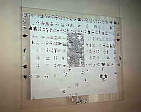 |
Phil Toy: 'Presumed
Missing' - made in Bosnia-Herzagovina in 1996 Artists' exchange Tuzla, Bosnia Artist living in Bristol, UK. He has exhibited in the UK, Holland and Germany. Whilst earlier work has focussed on fragmentation, his current work examines our history in a more conceptual way and increasingly is focusing on the observation that despite technological changes down the centuries - from flint tools and primitive weapons to the space age and IT - human nature remains unchanged. Images 'The pieces entitled 'Chance' and 'No Chance' were made in Tuzla, Bosnia-Herzogovina in 1996. I made them as a reaction to my visit during which I met other artists and, subsequently, organised and fund-raised for an exchange residency to take place between Tuzla and Bristol artists. In these works as in 'Migration' (the title refers to displaced people) I used jigsaw pieces. The individual pieces, quite literally look like small figures and there is a reference to 'the complete picture', or more accurately to a situation that is far from that. 'Presumed Missing' has jigsaw puzzle shapes cut out of the wood. It is a kind of homage, a small monument.' Phil Toy works at Spike Island Studios, Bristol UK top |
|
| War
Art and Artists : Theatres of War |
||

|
Michael Turner: 'Zur
Brucke' - an Installation on the Elbe "My sculpture and installation often respond to a site of conflict - I had, for example, an exhibition open in Berlin on the 50th anniversary of world war two. My installation for the project 'Zur Brucke' consisted of bird nesting / feeding stations placed alomg the 1500m. long Domitz Elbbrucke - one of the places where Russian and Allied armies met in 1945. The bridge subsequently linked / divided East and West Germany as the (disputed) border was formed by the Elbe. Birds establish their own territories and it is now possible to make an ironic comparison between ornithological and political borders." Michael Turner has exhibited throughout the UK and regularly in Germany: Gallerie Carsten Koch, Dusseldorf; Museum Fur Moderne Kunst, Frankfurt (1997) ; Galerie Hexagone, Aachen (1998) and APC Galerie Cologne (1998). His work is shown in 'Zur Brücke', (Holger Birkholz, ISBN 3 - 928117 - 08 - 4) and is illustrated in the catalogue 'love religion explosives' St Margaret's Church, Norwich, 1999 top |
|
| War
Art and Artists : Theatres of War |
||
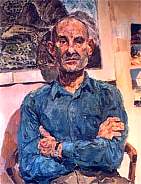
|
Susan Wilson: Families,
Father and meories of Monte Cassino "In my family, or 'Whanau', the men in my father's generation nearly all served at the battle of Monte Cassino, as gunners, stretcher bearers and in the Maori Battalion. In 1993 I went to Rome and Cassino on a British School at Rome / Abbey Award. I have returned annually to a remote mountain town below the Gustav Line. My work has been made here about this wild place where a generation before me spent so much perilous time. I am now part of a committee to raise money for commemorative gates to the New Zealanders who served in World War Two, at the Parliament Square entry point to St James Park. The experience of the New Zealanders in the Italian Campaign remains a rich field of research for my painting and writing." contact: gretton@cscolleg.attmail.com top back to featured artists |
|